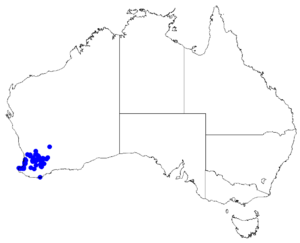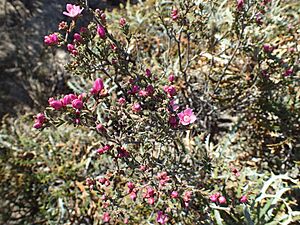Cluster boronia facts for kids
Quick facts for kids Cluster boronia |
|
|---|---|
 |
|
| Boronia capitata near Quairading | |
| Scientific classification | |
 |
|
| Occurrence data from Australasian Virtual Herbarium |
The Boronia capitata, also known as the cluster boronia, is a special plant. It belongs to the citrus family, called Rutaceae. This plant is found only in the south-west part of Western Australia. It is a thin, spreading bush with simple leaves. Its flowers are pink and have four petals.
What Does It Look Like?
The Boronia capitata is a slender, spreading shrub. It can grow from about 15 to 130 centimeters (6 to 51 inches) tall. It has simple, thick leaves. These leaves are shaped like a line or a club. They are usually 4 to 15 millimeters (0.16 to 0.59 inches) long.
The flowers are pink. They grow in clusters at the ends of the branches. Each flower sits on a tiny stalk, about 1 to 3 millimeters (0.04 to 0.12 inches) long. The plant has four sepals. These are like small leaves that protect the flower bud. They are broadly oval or narrow and triangular. The four petals are broadly oval and about 6 millimeters (0.24 inches) long.
How It Got Its Name
The Boronia capitata was first officially described in 1863. A botanist named George Bentham wrote about it. He published his description in a book called Flora Australiensis. He used a plant sample collected by James Drummond.
The second part of its scientific name, capitata, is a Latin word. It means "having a head". This likely refers to how its flowers grow in clusters.
In 1971, another botanist, Paul G. Wilson, described three types of this plant. These are called subspecies:
- Boronia capitata subsp. capitata: Its leaves and sepals are smooth or have a fringe of hairs. It flowers from September to October.
- Boronia capitata subsp. clavata: It has thick leaves covered with long, soft hairs. Its sepals are broadly oval with a fringe of hairs. It flowers from April to October.
- Boronia capitata subsp. gracilis: It has slender leaves covered with long, soft hairs. Its sepals are narrow and egg-shaped with a hairy fringe. It flowers from June to November.
Where It Grows
Each subspecies of Boronia capitata grows in different areas:
- Subspecies capitata is currently only found in sandy plains. These are near Pingelly.
- Subspecies clavata grows in heathland. This area is between Corrigin, Hyden, and Kojonup.
- Subspecies gracilis grows in swamps that are wet in winter. These are found between Yarloop and Margaret River.
Protecting the Plant
The subspecies clavata is considered "not threatened". This means it is not in danger of disappearing.
However, subspecies gracilis is classified as "Priority Three". This means it is not very well known. It is found in only a few places. But it is not in immediate danger. This classification comes from the Government of Western Australia Department of Parks and Wildlife.
Subspecies capitata is listed as "endangered". This is under the Australian Government Environment Protection and Biodiversity Conservation Act 1999. It is also listed as "Threatened Flora (Declared Rare Flora — Extant)" by the Department of Environment and Conservation (Western Australia). The biggest dangers to this subspecies are:
- Clearing its habitat: This means its natural home is being removed.
- Fragmentation: This means its habitat is being broken up into smaller, separate pieces.


